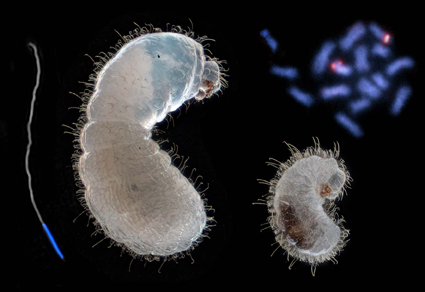References
- Baer, B., Dijkstra, M.B., Mueller, U.G., Nash, D.R. & Boomsma, J.J. (2009) Sperm length evolution in the fungus-growing ants. Behavioral Ecology, 20, 38–45. https://doi.org/10.1093/beheco/arn112
- Barros, L.A.C., Chaul, J.C.M., Orivel, J. & Aguiar, H.J.A.C. (2021) Cytogenetics of Strumigenys louisianae Roger, 1863 (Formicidae: Myrmicinae) from North-eastern Amazonia shed light on a difficult species complex. Zoologischer Anzeiger, 294, 100–105. https://doi.org/10.1016/j.jcz.2021.07.012
- Barros, L.A.C., Chaul, J.C.M., Teixeira, G.A., Lod, R.B., Orivel, J. & Aguiar, H.J.A.C. (2022) First Report of the Tramp ant Technomyrmex vitiensis Mann, 1921 (Formicidae: Dolichoderinae) in Brazil with Cytogenetic and Sperm Structure Data and an Updated Key to Brazilian Dolichoderinae Genera. Zoological Studies, 60. https://doi.org/10.6620/ZS.2022.61-29
- Chaul, J.C.M. (2022) Redescription of Eurhopalothrix reichenspergeri (Santschi, 1923) stat. rev. (Hymenoptera: Formicidae), a Brazilian Atlantic Forest endemic species. Zootaxa, 5182 (1), 1–20. https://doi.org/10.11646/zootaxa.5182.1.1
- Cristiano, M.P., Cardoso, D.C. & Fernandes-Salomão, T.M. (2013) Cytogenetic and molecular analyses reveal a divergence between Acromyrmex striatus (Roger, 1863) and other congeneric species: taxonomic implications. PLoS One, 8 (3), e59784. https://doi.org/10.1371/journal.pone.0059784
- Imai, H., Taylor, R.W., Crosland, M.W. & Crozier, R.H. (1988) Modes of spontaneous chromosomal mutation and karyotype evolution in ants with reference to the minimum interaction hypothesis. The Japanese Journal of Genetics, 63, 159–185. https://doi.org/10.1266/jjg.63.159
- Levan, A., Fredga, K. & Sandberg, A.A. (1964) Nomenclature for centromeric position on chromosomes. Hereditas, 52, 201–220. https://doi.org/10.1111/j.1601-5223.1964.tb01953.x
- Moya, J., Mancini, K., Lino-Neto, J., Delabie, J. & Dolder, H. (2007) Sperm ultrastructure of five species of the Neotropical ant genus Pseudomyrmex (Hymenoptera: Formicidae). Acta Zoologica, 88 (3), 181–187. https://doi.org/10.1111/j.1463-6395.2007.00264.x
- Penick, C.A., Copple, R.N., Mendez, R.A. & Smith, A.A. (2012) The role of anchor-tipped larval hairs in the organization of ant colonies. PLoS One, 7 (7), e41595. https://doi.org/10.1371/journal.pone.0041595
- Pereira, J.O.P. (2006) Diversidade genética da abelha sem ferrão Melipona quinquefasciata baseada no sequenciamento das regiões ITS1 parcial e 18S do DNA ribossômico nuclear. https://doi.org/D.Sc. Tese, Programa de Pós-graduação em Zootecnia. Universidade Federal do Ceará, Fortaleza-CE-BrazilFortaleza, Ceará, 141 pp.
- Pinkel, D., Straume, T. & Gray, J.W. (1986) Cytogenetic analysis using quantitative, high-sensitivity, fluorescence hybridization. Proceedings of the National Academy of Sciences of the United States of America, 83, 2934–2938. https://doi.org/10.1073/pnas.83.9.2934
- Santschi, F. (1923) Solenopsis et autres fourmis néotropicales. Revue Suisse de Zoologie, 30, 245–273. https://doi.org/10.5962/bhl.part.117787
- Schlick-Steiner, B.C., Steiner, F.M., Seifert, B., Stauffer, C., Christian, E. & Crozier, R.H. (2010) Integrative taxonomy: a multisource approach to exploring biodiversity. Annual Review of Entomology, 55, 421–438. https://doi.org/10.1146/annurev-ento-112408-085432
- Schneider, C., Rasband, W. & Eliceiri, K. (2012) ImageJ. Nature Methods, 9 (7), 671–675. https://doi.org/10.1038/nmeth.2089
- Teixeira, G.A., Aguiar, H.J.A.C., Petitclerc, F., Orivel, J., Lopes, D.M. & Barros, L.A.C. (2021) Evolutionary insights into the genomic organization of major ribosomal DNA in ant chromosomes. Insect Molecular Biology, 30 (3), 340–354. https://doi.org/10.1111/imb.12699
- Wheeler, G.C. & Wheeler, J. (1954) The ant larvae of the myrmicine tribes Basicerotini and Dacetini. Psyche (Cambridge) 6,111–145. https://doi.org/10.1155/1954/49606
- Wilson, E.O. (1956) Feeding behavior in the ant Rhopalothrix biroi Szabó. Psyche (Cambridge), 63, 21–23. https://doi.org/10.1155/1956/23572


